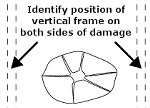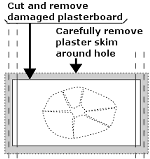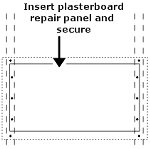How to repair
large holes in plasterboard walls/ceiling
Before buying any plasterboard to make a repair, check the thickness of plasterboard currently used - two thicknesses are commonly available, 13mm (1/2 inch) and 8mm (3/8 inch).
The below guide lines are written as if for a plasterboard wall, however they are equally applicable for plasterboard ceilings, just change all references to 'vertical frames' to 'joists'.
 Locate the positions of the vertical frames on both sides of the damaged area.
Locate the positions of the vertical frames on both sides of the damaged area.  Cut out the damaged part of the plasterboard - position the vertical cuts half way across the front of the uprights (these are typically 50mm (2 in) wide) - use a sharp craft knife. - check before cutting that there are no cables behind the plasterboard, don't worry too much about pipework as it won't be damaged by the small knife.
Cut out the damaged part of the plasterboard - position the vertical cuts half way across the front of the uprights (these are typically 50mm (2 in) wide) - use a sharp craft knife. - check before cutting that there are no cables behind the plasterboard, don't worry too much about pipework as it won't be damaged by the small knife.
- If the front of the existing plasterboard has been skimmed with plaster, carefully remove a strip of plaster about 50mm (2 inch) around the hole (this will make it easier to blend the repair in with the surrounding, original plasterwork). Use a metal straightedge to score the plaster skim, then use a filling knife or scraper to carefully remove the strip of plaster.
 Cut a piece of plasterboard to fit the hole and insert it. Secure the new piece of plasterboard to the uprights using plasterboard nails or screws. Also secure the surrounding plasterboard to the uprights just above and below the repair panel.
Cut a piece of plasterboard to fit the hole and insert it. Secure the new piece of plasterboard to the uprights using plasterboard nails or screws. Also secure the surrounding plasterboard to the uprights just above and below the repair panel. - Apply scrim over the joint between the repair panel and the original plasterboard.
- If the original plasterboard had a plaster skim, apply a thin coat of plaster over the entire repair and smooth it off to the level of the existing plaster.
